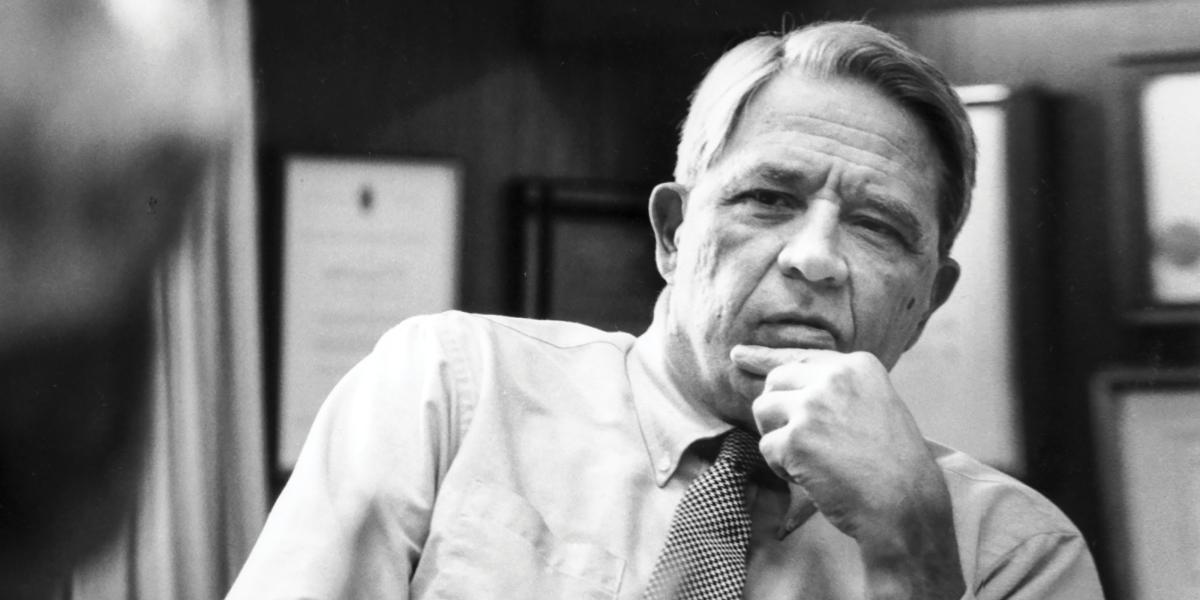Lessons From a Legend
D.A. Henderson did much more than eradicate smallpox.
After D.A. Henderson passed away on August 19, global media coverage focused on the role that made him famous: his leadership of WHO’s successful Smallpox Eradication Programme, which annihilated the biggest killer in history. His encore role as dean of the then-Johns Hopkins School of Hygiene and Public Health typically merited just a sentence or two. But Dean Henderson left a lasting imprint on public health education at Johns Hopkins and nationally, through his leadership in the Association of Schools of Public Health. Henderson, MD, MPH ’60, was by turns glowingly optimistic and scathingly critical about American schools of public health. When a period of trials threatened the School’s very existence, he led changes that fostered unprecedented growth in its scope and influence. Here is what he taught us.
Fighting epidemics gives you an increased sense of urgency and higher purpose.
When Henderson became dean in 1977, double-digit inflation was wrecking the economy. Johns Hopkins University and federal health programs both faced severe budget shortfalls. Henderson believed that American public health professionals had been “relegated to the periphery by the evolution of medical and health practice.” Yet smallpox eradication had reinforced his “personal optimism that we [in public health] have the capacity to meet the challenges of the coming decades.” The greatest public health challenge of the 1980s was the AIDS epidemic. In a 1987 New York Times op-ed, Henderson called for greater international cooperation to fight the disease and denounced the U.S. default on its $100 million-plus debt to the WHO. Correctly predicting AIDS’ dominance of the international agenda, he urged Western nations to bolster spending on AIDS programs in developing countries. In 1987, Henderson spearheaded the founding of the Johns Hopkins Center for AIDS Research and Education. Among the first of its kind and the largest outside of NIH, the Center greatly improved collaboration between the schools of Public Health and Medicine. The School also established three anchors for HIV/AIDS research: the Multicenter AIDS Cohort Study (MACS) in 1984, the Immunization Research Center in 1985, and the AIDS Linked to the Intravenous Experience (ALIVE) Study in 1987. Together, these yielded groundbreaking knowledge about the virology, epidemiology and behavioral aspects of HIV/AIDS.
Get out from behind your desk and into the street.
Like Alexander Langmuir, MD, MPH ’40, his mentor and former boss at the CDC’s Epidemic Intelligence Service, Henderson had no use for “paper pushers” or “shiny pants epidemiologists” who never talked to people out in the community. He saw most schools of public health as out of touch and insufficiently involved in practical problem solving. Vowing to make the School “fully relevant to the work-place,” he reformed its flagship educational programs and established several new ones. To lead the first major revisions to the MPH degree in two decades, Henderson appointed Abraham Lilienfeld, MD, MPH ’49, as the program’s first full-time director. He tapped Associate Dean Edyth Schoenrich, MD, MPH ’70, to reconfigure the General Preventive Medicine Residencyto include primary care and experience in health agencies and medical care systems. By establishing the Graduate Summer Institute of Epidemiology and Biostatistics (1983), the Occupational and Environmental Medicine Residency (1985), and the first continuing education programs, Henderson rounded out the comprehensive upgrade of the School’s degree and non-degree programs.
D.A. was impressive and imposing: tall confident, articulate and a fierce advocate for his faculty and the school. He was a force of nature who ... seemed invulnerable. —Dean Michael J. Klag
Effective management and information technology are essential.
Henderson prized the art and science of management and wanted to apply business administration principles to the health care sector and the School. He thought the health sector had “lagged far behind” other economic sectors in adopting key management tools like measurement and evaluation. He believed that the School could help improve the collection and analysis of community data on “disease prevalence, utilization and costs of health services, and environmental and behavioral risk factors.” Recognizing computers as crucial for better management and policy formulation, Henderson ushered in the era of Big Data at the School by dramatically expanding computer infrastructure. The 1980s computer revolution also supported new initiatives to apply health services research and a primary care framework in shaping policy. With a reorganization that resulted in the creation of the Health Policy and Management (HPM) department in 1983, Henderson, with HPM chair Karen Davis, PhD, guided faculty in shaping national debates on the organization and financing of health care under Medicare and Medicaid, particularly in developing state Children’s Health Insurance Programs. When Henderson left the deanship in 1990, he had achieved his No. 1 priority: to fully engage the School in solving some of the world’s most consequential public health problems, including air pollution, HIV/AIDS, auto-immune disease, child survival and injury prevention.
-
1960
Earns an MPH from the School
-
1966
Appointed director of the WHO Smallpox Eradication Programme
-
1977
Named the eighth dean of the School
-
1980
WHO certifies that smallpox is eradicated worldwide
-
1986
Receives the National Medal of Science
-
2002
Awarded the Presidential Medal of Freedom for biodefense leadership
